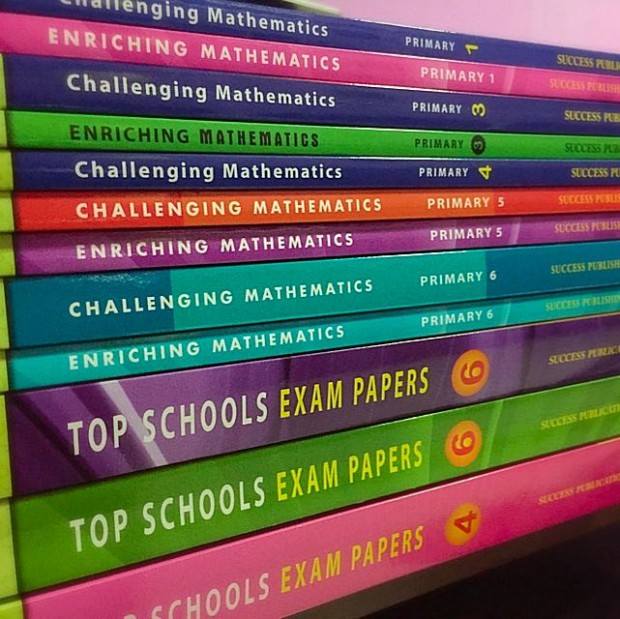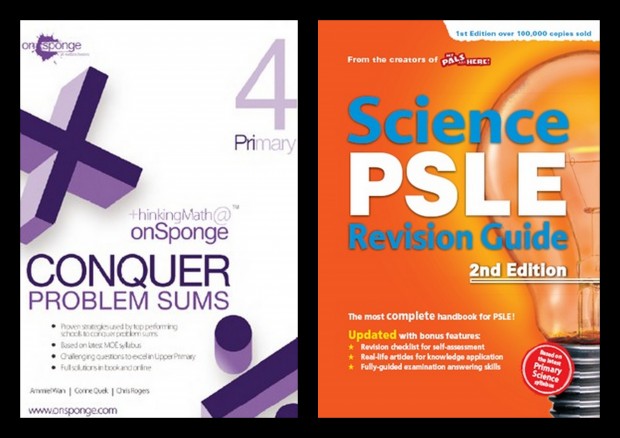If you have never touched an assessment book in your life, you clearly haven’t studied in Singapore. A wise man once said, “The more assessments you do, the better your results” (ok, I lied. I came up with that!) So being the very good mummy that I am, not wanting to short-change my kids in this ridiculous rat-race they are in, I am the self-proclaimed Queen of Assessment Books.
I am queen not because I have a huge collection of assessment books. I am queen not because I know all my subjects (haha..literally and figuratively!). I am queen not because I work in a publishing house. You see, I AM QUEEN because I found the secret to managing the Assessment Books! Muahahahahahaah!
Let me share how I learnt this secret! It started in 2011, when Nicole was in P1. I was very determined and anxious that I will not WASTE my money buying excessive numbers of assessment books and they will be incomplete at the end of the year. I remembered my growing up years and how I hated books that were badly printed, small fonts, lousy quality paper. And what’s worse, if the exercises were too easy, or too repetitive. (Imagine 100 pages of Vocabulary MCQs!!!)
So I decided to spend good time flipping through the assessment books, ensure they pass my somewhat Stringent criteria before I buy them. I didn’t buy too many (about 3 for each subject for varying types of questions). I listed out my criteria below. I left out Chinese, for obvious reasons of inadequacy.
And I did buy a good qualitative collection for Nicole’s P1. But I was unable to see it through! I forgot what I bought, which meant my grand plans of alternating between Books A and B went down the drain. All those schedules of ensuring she would have a good foundation in a particular topic before she tackles a test went poof! On top of that, my intelligent P2 girl knows which assessment books have difficult questions. She went to HIDE the books periodically. And this mummy totally forgot what she has! And I have quite a collection of uncompleted books at the end of the year!
But thank God there was little academic emphasis in P1. So in P2, I took pictures of each book and have it in my laptop. Don’t tell me you don’t know which book I’m referring to, or you lost the book! I have the picture!! It worked!! I could call home from work and tell her what needs to be done. She tried ‘losing’ her book, and I could show her the picture and make her hunt it down! woohooo!!
Here’s what I did for Nathan’s P1 books. A Screenshot of the folder in my laptop!
That’s my secret! Knowledge is power! Know what you have, and you can manage the books and use it effectively!
Having said that, I also found the Past Years’ papers from the Top Schools very effectively. There are answer sheets for easy marking and most importantly, the papers make very good revision papers throughout the year! Look at where the papers come from!
So now, here’s my personal tips on how to choose Assessment Books! This is for Lower Primary and Primary 4, as yours truly is only familiar with P1-P4 thus far! (Marshall Cavendish books have never failed me!)
MATHS/SCIENCE
-
Don’t buy too many assessments with TERM PAPERS. You can only do these papers when the child has completed learning all the relevant topics.
-
Get Assessments with topical exercises. Your child can do exercises on Addition from Book A, and later revise with Book B, and if you have Book C.
-
The assessments should be of varying difficulties. Book A is the basic exercises for foundation practice. Book B require higher level thinking etc.
- One of the best Math assessment books is Thinking Math @On-Sponge–Conquer Problem Sums. This is available from the ThinkingMath website or selected school bookstores. It gives good sums for the kids to work on, and excellent clear solutions that we can use to explain to the kids. This is a highly recommended book from the many many parents I’ve spoken to who had primary school kids up to 4 years ago!
- And the hot favourite for Science revision is Science PSLE Revision Guide 2nd Edition. (Bright Orange book!) This is by my favourite Marshall Cavendish and it is clear and concise in its explanation. Do note that this is not an assessment book but a Guide with all the notes needed for the exam. By now, you would have realised that your kids’ Science Textbook is really thin and quite lacking in content. They have to take notes in school and study supplement notes given by the teachers. Thus, this Revision Guide is a God-sent.
ENGLISH
-
Focus on the different sections of the Exam Paper. That is, buy a book on Synthesis, another on Comprehension, another on Vocabulary. Focus on what your child needs practice on.
-
When buying books on Comprehension, avoid books which has the passage and questions that are not on facing pages. The child get frustrated flipping the pages to look for answers, and would not finish this book!
-
Do get at least one book that tests the FULL scope of an English paper. This should include grammar, vocabulary, cloze passage, comprehension, composition etc.
Please understand that I’m not enjoying my title as Queen. I never liked assessment books when I was a child, and I still don’t like them now that I’m a mum.
BUT I know they are important, so this really is the least I can do to ensure money’s not wasted, and of course, they understand what’s happening in school. It’s simply not possible to go through school life without assessment books (I’m not referring to the hotly debated topic TUITION). I pray that my kids come to that place of enjoying the learning journey, with the assessment books. Keep smiling babies!
 Do you have your own guidelines how you choose Assessment Books? Please share!!
Do you have your own guidelines how you choose Assessment Books? Please share!!
Update 2015
I’ve downsized the number of books per subjects. We are now at 1 book per subject, and past year papers. Past year papers are super useful. Here’s a good link you can use to access the papers and print as and when you need them! They have papers from 2000. This is an excellent website and I am so grateful to the guys who set it up! Here you go: Past Years Papers




